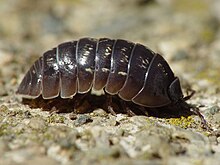Armadillidiidae
| Armadillidiidae | |
|---|---|

| |
| Armadillidium vulgare | |

| |
| Armadillidium vulgare in its defensive posture | |
| Scientific classification | |
| Kingdom: | |
| Phylum: | |
| Subphylum: | |
| Class: | |
| Order: | |
| Suborder: | |
| Family: | Armadillidiidae Brandt, 1833
|
| Genera | |
|
See text | |
The term 'Pillbug' redirects here. For the American band, see The Pillbugs
Armadillidiidae is a family of woodlice, a terrestrial crustacean group in the order Isopoda. Unlike members of other woodlouse families, members of this family can roll into a ball, an ability they share with the outwardly similar but unrelated pill millipedes and other animals. It is this ability which gives woodlice in this family their common name of pill bugs or roly polies. The best known species in the family is Armadillidium vulgare, the common pill bug.
Ecology and behaviour
Woodlice in the family Armadillidiidae are able to form their bodies into a ball shape, in a process known as conglobation. This behaviour is shared with pill millipedes (which are often confused with pill bugs[1]), armadillos and cuckoo wasps.[2] This behaviour may be triggered by stimuli such as vibrations or pressure, and is a key defence against predation; it also serves to reduce water loss through respiration.[3]
Relationships with people
Because of their unusual yet non-threatening appearance, certain types of armadillidiidae (typically the Armadillidium vulgare) are kept as pets in areas such as the American South, typically among children. Among adults, they are often seen as unwanted (but essentially harmless) home pests.[4] Keeping a pet pill bug requires a very moist habitat with limited light.[5] They can live up to about three years.[4]
Owners of pet tarantulas sometimes keep pill bugs as companions in the same habitat.[5] They are sometimes caught and fed to pets such as iguanas and other lizards, but this is not recommended since those animals might become poisoned.[6]
Pill bug characters named Tuck and Roll were part of the popular Pixar family film A Bug's Life. They were voiced by American actor-comedian Michael McShane.[7][8]
Classification
The family Armadillidiidae is differentiated from other woodlouse families by the two-segmented nature of the antennal flagellum, by the form of the uropods, and by the ability to roll into a ball.[9]
Within the family Armadillididae, fourteen genera are currently recognised:[10]
External links
- Regional maps for the most common American names for this isopod can be found in the results for question 74 of the Harvard Dialect Survey.
References
- ^ "Pill millipede (Glomeris marginata)". ARKive. Retrieved 2007-06-21.
- ^ Edward M. Barrows (2001). Animal behavior desk reference: a dictionary of animal behavior, ecology, and evolution (2nd ed.). CRC Press. p. 142. ISBN 9780849320057.
- ^ Jacob T. Smigel & Allen G. Gibbs (2008). "Conglobation in the pill bug, Armadillidium vulgare, as a water conservation mechanism" (PDF). Journal of Insect Science. 8 (44): 1–9. doi:10.1673/031.008.4401. PMID 20233103.
- ^ a b Smith-Rogers, Sheryl (October 2009). "Wild Thing: Roly-Poly Pillbugs". TPW Magazine. Retrieved July 10, 2010.
{{cite web}}: Italic or bold markup not allowed in:|publisher=(help) - ^ a b Stanley A. Schultz; Marguerite J. Schultz (2009). The Tarantula Keeper's Guide: Comprehensive Information on Care, Housing, and Feeding. Barron's Educational Series. pp. 181–183. ISBN 9780764138850.
- ^ Adamson, Eve (2005). Adopting a Pet For Dummies. For Dummies. p. 325. ISBN 9780764598791.
- ^ "Pixar - A Bug's Life - The Characters". pixar.com. Retrieved July 10, 2010.
{{cite web}}: External link in|publisher= - ^ "A Bugs Life (1998) - Full cast and crew". Imdb.com. Retrieved July 10, 2010.
- ^ P. J. Hayward & John Stanley Ryland (1995). "Crustaceans". Handbook of the marine fauna of north-west Europe. Oxford University Press. pp. 289–461. ISBN 9780198540557.
- ^ Helmut Schmalfuss (2003). "World catalog of terrestrial isopods (Isopoda: Oniscidea) — revised and updated version" (PDF). Stuttgarter Beiträge zur Naturkunde, Serie A. 654: 341 pp.
